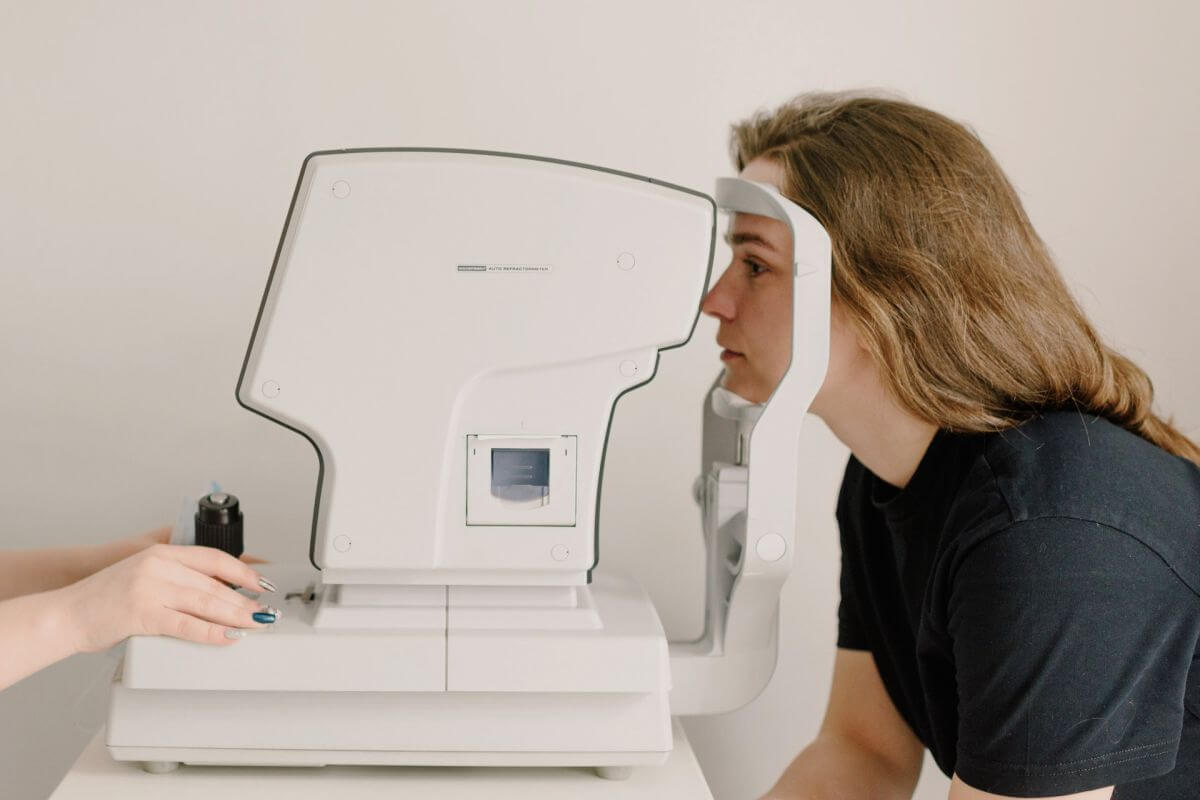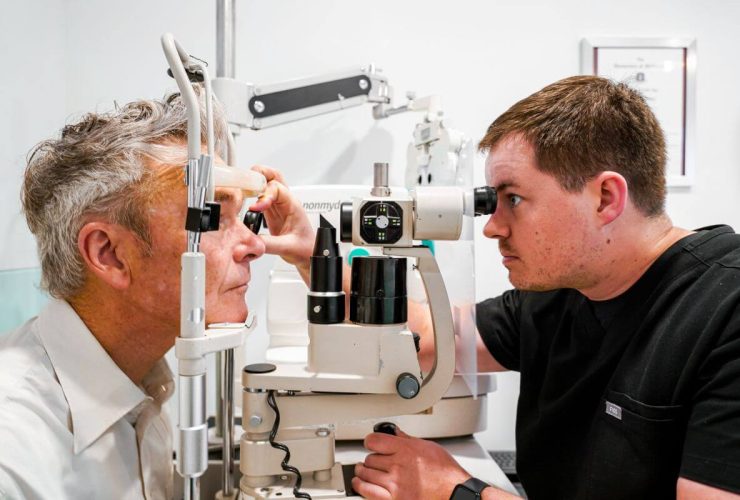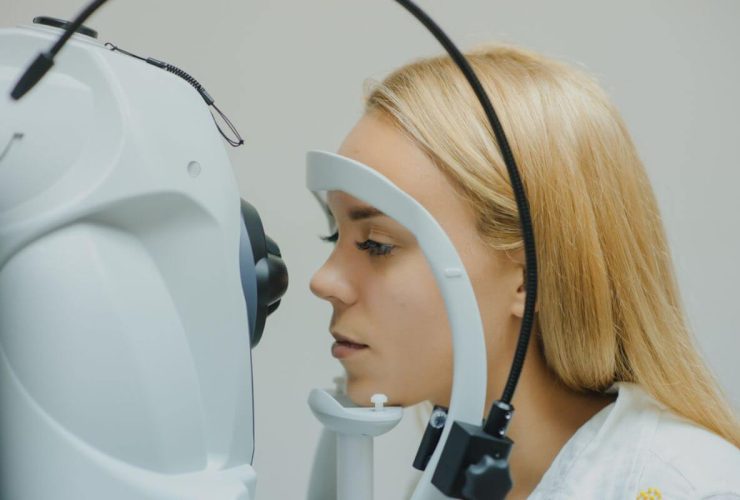Understanding Your OCT Results: What Do the Images Show?
If you’ve recently had an OCT scan at your eye doctor’s office, you might have seen colorful, layered images of your eye on the screen. Your doctor probably explained what they meant, but it’s normal to leave wondering, “What exactly am I looking at?”
Optical Coherence Tomography (OCT) has become one of the most important tools in modern eye care. It helps detect eye conditions long before symptoms appear. This article breaks down what OCT is, how it works, what those images actually show, and how to understand your OCT results in simple terms. Whether you’ve had a scan for glaucoma, macular degeneration, or a routine check-up, this guide will help you make sense of the images and what they reveal about your eye health.
What Is an OCT Scan and How Does It Work?
A Quick Look at the Technology
OCT stands for Optical Coherence Tomography. It’s a non-invasive imaging technique that uses light waves to take cross-sectional pictures of the retina—the light-sensitive tissue lining the back of your eye. Think of it like an ultrasound, but instead of using sound waves, it uses light to capture high-resolution images of the different layers of your retina.
In just a few seconds, the machine scans your eye and builds a detailed, 3D image. This allows eye specialists to measure the thickness of each retinal layer and identify even the smallest changes that may signal disease.
Why OCT Matters in Modern Eye Care
Before OCT, doctors relied heavily on what they could see through direct examination or photographs of the retina. While useful, those methods didn’t show what was happening beneath the surface. OCT changed that completely.
Today, it’s used to detect and monitor conditions like:
- Glaucoma
- Age-related macular degeneration (AMD)
- Diabetic retinopathy
- Macular holes and epiretinal membranes
- Optic nerve disorders
By comparing your OCT results over time, your doctor can track disease progression and determine whether treatments are working effectively.
Breaking Down the OCT Image: What You’re Seeing
When you look at your OCT results, you’ll typically see colorful cross-sections of your retina. To an untrained eye, they may look confusing, but each color and line represents something important.
The Layers of the Retina
The retina has several layers, and OCT can visualize each one. From top to bottom, the main layers include:
- Nerve Fiber Layer (NFL) – This is the top layer closest to the inner eye surface. It contains nerve fibers that connect to the optic nerve.
- Ganglion Cell Layer (GCL) – Contains the cell bodies of neurons that send signals to the brain.
- Inner and Outer Plexiform Layers – Where nerve cells connect and transmit visual signals.
- Photoreceptor Layer – Houses rods and cones that detect light and color.
- Retinal Pigment Epithelium (RPE) – A thin layer that nourishes the retina and removes waste.
Each of these layers plays a vital role in how the eye captures and processes light.
In the OCT image, colors often represent reflectivity:
- Red and yellow = highly reflective areas (like the nerve fiber layer)
- Green = moderately reflective
- Blue and black = less reflective areas (like the photoreceptor layer or fluid pockets)
So, when your doctor points to a bright red band, that’s typically a dense, healthy structure. A dark space could indicate fluid or damage.
Common Findings on OCT and What They Mean
Every patient’s OCT scan looks slightly different, but there are a few common findings that help explain what’s going on inside your eye.
1. Normal Retina
A normal OCT result shows smooth, evenly layered structures without disruptions. The macula—the central part responsible for sharp vision—should appear as a gentle dip. The optic nerve head should look clean and well-defined, with no swelling or thinning.
2. Macular Edema
If your OCT shows dark spaces or swelling in the macula area, this could be macular edema, often caused by diabetic retinopathy, vein occlusion, or inflammation. The dark spaces represent fluid that’s leaked into the retinal tissue.
3. Age-Related Macular Degeneration (AMD)
In dry AMD, you may see small bumps or deposits called drusen under the retina. In wet AMD, the OCT may reveal fluid or bleeding beneath the retina caused by abnormal blood vessels. The scan helps determine the stage and guides treatment, such as anti-VEGF injections.
4. Glaucoma
For glaucoma patients, OCT focuses on the optic nerve head and the nerve fiber layer. Thinning in these areas may indicate nerve damage. Comparing your scans over time helps your doctor see if the disease is stable or progressing.
5. Retinal Holes and Epiretinal Membranes
If there’s a tear or a membrane pulling on the retina, OCT can show distortions or traction. Early detection through OCT often prevents further vision loss.
How to Interpret OCT Measurements
Your OCT report may include numeric data, charts, and color-coded maps in addition to the images. Here’s how to understand what they mean.
Retinal Thickness Map
This map shows the thickness of your retina in micrometers. Different zones are color-coded—green typically means “normal,” yellow or red may indicate thinning or thickening.
- Normal macular thickness: Usually between 250–300 micrometers.
- Thinner readings may signal atrophy or glaucoma.
- Thicker readings can indicate swelling, fluid buildup, or inflammation.
Optic Nerve Analysis
The optic nerve section measures the Retinal Nerve Fiber Layer (RNFL) thickness. A “heat map” shows whether certain areas are losing nerve fibers.
For example:
- Green = Normal range
- Yellow = Borderline thinning
- Red = Significant thinning
Doctors use this data to monitor glaucoma and other optic nerve conditions over time.
Progression Reports
If you’ve had multiple OCT scans, your doctor may compare them to look for changes. Even a small difference in retinal or nerve fiber thickness over time can be an early sign of disease progression.
Understanding OCT in Different Eye Conditions
To see how powerful OCT can be, here’s how it helps diagnose and manage a few common eye problems:
1. Diabetic Retinopathy
OCT detects early fluid buildup or swelling long before vision changes occur. This allows for timely intervention, such as laser treatment or injections, to prevent permanent vision loss.
2. Macular Degeneration
OCT helps distinguish between the dry and wet forms of AMD and tracks treatment response. For wet AMD, it’s used regularly to see if fluid is returning, which guides injection schedules.
3. Glaucoma
By measuring the thickness of the retinal nerve fiber layer and optic disc changes, OCT gives an objective way to track glaucoma progression. It’s more sensitive than visual field tests alone.
4. Retinal Detachment
In suspected cases, OCT helps confirm whether the retina has separated from its underlying tissue and whether fluid has accumulated.
5. Post-Surgery Monitoring
After cataract or retinal surgery, OCT can detect subtle swelling or inflammation, ensuring recovery is on track.
Limitations of OCT Scans
While OCT is an incredible tool, it does have limitations:
- It provides structural, not functional, information. In other words, it shows what the retina looks like, not how well it’s working.
- Image quality can be affected by media opacities like cataracts or corneal scars.
- It doesn’t always replace other tests, such as fluorescein angiography or visual field analysis.
- Interpretation still requires clinical expertise; no scan can replace a full eye examination.
Despite these limitations, OCT remains one of the most precise ways to detect and monitor subtle retinal and optic nerve changes.
Why Regular OCT Scans Are Important
Even if your vision seems fine, regular OCT scans are essential—especially if you’re at higher risk for eye diseases. Conditions like glaucoma or macular degeneration often develop silently. By the time symptoms appear, irreversible damage may have already occurred.
Routine OCT imaging allows:
- Early detection of microscopic changes.
- Personalized monitoring of treatment response.
- Peace of mind knowing your eye health is being tracked accurately.
Your doctor will recommend how often you should have an OCT scan based on your age, family history, and eye health status.
How to Read Your OCT Results with Your Doctor
It’s important to go over your OCT scan results together with your eye doctor. They’ll explain what each image and measurement means in the context of your eye health. Here are a few smart questions you can ask:
- Are my OCT results within the normal range?
- Have there been any changes since my last scan?
- Do you see any signs of thinning, swelling, or fluid?
- How do these findings affect my current treatment plan?
Having this discussion helps you stay involved in your care and better understand your visual health.
Conclusion: Take an Active Role in Your Eye Health
Understanding your OCT results is more than just interpreting colors on a screen—it’s about staying informed and proactive in protecting your vision. The images reveal a detailed map of your retina, offering early warning signs of diseases that can threaten sight if left untreated.
If your doctor recommends regular OCT scans, take them seriously. These images give valuable insights into your eye’s condition and help guide the best course of care.
If it’s been a while since your last eye check-up, schedule one today. A simple, painless OCT scan could be the key to preserving your vision for years to come.




